When Hurricane Irma unleashed its fury on Florida last month, many residents in coastal Brevard County whose homes were damaged and utilities cut off qualified for FEMA assistance. But they know how to rebuild. They’ve done it many times before—and not just as a result of natural disasters. This region has made a comeback from the biggest economic storm in the last quarter-century.
Home of the Kennedy Space Center, Brevard County, which has about 570,000 residents, went from 1,868 total foreclosures in 2008 to 9,228 in 2009. By the end of 2011, the county had the highest foreclosure rate in the country—four times the national average at that point. The area experienced a collision between two major economic problems: the recession and the retirement of NASA’s Space Shuttle program—a major local employer. According to research from the University of West Florida Office of Economic Development and Engagement, the Palm Bay-Melbourne-Titusville area lost a net 6,800 jobs. The Space Coast Economic Development Commission estimates layoffs at closer to 10,000.
“Everyone knew well in advance that the shuttle program was retiring,” says Lynn Jones, sales associate with Coldwell Banker Residential Real Estate in Melbourne, Fla., and 2017 president of the Space Coast Association of REALTORS®. “A lot of people planned in advance and made their moves [out of the area].” Indeed, President George W. Bush announced in January 2004 that the Space Shuttle program would retire in 2010 (which was later extended to 2011) to make way for the development of new spacecraft.
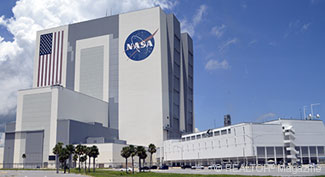
“It was a domino effect; they say every job here [at Kennedy Space Center] correlates to about three jobs on the outside,” says Stephan, who knows of many people who relocated to find work. As a longtime resident, Stephan chose to stay, dipping into his 401(k) and savings to make ends meet.
The timing of the program’s retirement could not have been foreseen. Jones, SFR, who has been practicing real estate in Brevard County since 1989, says the market had been steady and predictable until about 2006. Then it climbed rapidly over a two-year period until it came to a screeching halt.
“From 2005 to 2007, it was nuts. Your dog could apply for a mortgage and get one,” says Mike Artelli, leader of the Artelli Real Estate Team at RE/MAX Solutions on Merritt Island, Fla., and president-elect of the Space Coast Association of REALTORS®. But as soon as a problem or repair came up, it led to financial hardship so severe that some homeowners could no longer afford their mortgage, he says.
The subprime lending debacle wasn’t the only blow to Florida’s economy in the years before and during the downturn. In 2004, the state was hit by four storms: Charley, Frances, Ivan, and Jeanne. As a result, a lot of homeowners needed to make repairs. By 2005, mortgages were easy to get, and many homeowners took out second mortgages to make renovations, updates, or pay off other bills. The situation continued to escalate as Brevard County’s unemployment hit 11.8 percent in 2010. “I was one of thousands applying for jobs,” Stephan says. Luckily, he was able to keep his house while weathering the financial crisis.
“It was insane for a long time,” says Melanie Schrader, SRES, an agent with Real Estate Direct in Melbourne. “You go into the houses afterwards, and it’s sad because you know families moved out of there and who knows where they went.”
But circumstances have changed for the better in Brevard County since then. Foreclosure activity in the area this year has dropped to the lowest level since November 2005, according to RealtyTrac. Brevard County has gone from one foreclosure in every 158 housing units in November 2011 to one in every 1,292 today, and unemployment is down to 4.4 percent. So, what’s behind this comeback?
The Diversification of the Space Coast
The Space Coast Economic Development Commission played a major role in diversifying the region’s economy by marketing the area to a variety of industries and working with local and state lawmakers to create business incentives, such as tax breaks. The Space Coast EDC attracted business in aviation, aerospace, shipbuilding, and high-tech manufacturing, among other industries.
“[Brevard County has] turned around in what I consider one of the shortest amounts of time,” says Lynda Weatherman, president and CEO of the Space Coast EDC. The commission identified the economic threat of the shuttle program’s retirement early, then created an aggressive marketing campaign on behalf of the community. “That doesn’t mean it came easy here. We had to compete,” she says. “We had a county commission that was willing to back us, and we had the backing of the state.” That coalition helped solidify incentives for big expansion projects and new businesses.
From January 2009 to July 2017, the EDC’s efforts helped create 8,336 new jobs and retain another 7,297 in the region. “The EDC did a great job of making sure this won’t happen to us again,” says Lindsay Sanger, GRI, broker-owner of RE/MAX Solutions, which has three offices in Brevard County. She opened her first office in 2014 after working as an agent for 10 years. “I took a look at what was happening in the economy and the real estate market, and decided it was a good time to grow a real estate business.” She says business has been increasing since she started her brokerage because of the EDC’s efforts.
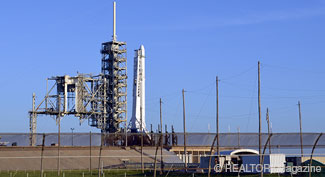
The retirement of the Space Shuttle program made way for today’s new era of commercial spaceflight, which is being led by companies such as Orbital ATK (which is being acquired by Northrop Grumman), Sierra Nevada Corp., and of course, SpaceX, Elon Musk’s company. The three companies have transport cargo contracts with the International Space Station through 2024 that potentially are worth $14 billion. Besides flying cargo for NASA, SpaceX is taking private clients in the commercial satellite and telecom arena, as well as government science missions and military national security missions. SpaceX has independently discussed plans to launch private citizens into space, including an orbital flight around the moon in late 2018. And Blue Origin, owned by Amazon CEO Jeff Bezos, has set up shop in Brevard County and is building its Orbital Launch Vehicle. It also has plans for a lunar lander.
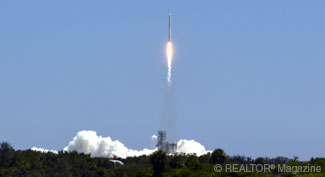
Brevard County also has Patrick Air Force Base, Cape Canaveral Air Force Station, and the Naval Ordnance Test Unit. Missions include harboring a Trident Nuclear Sub and monitoring nuclear activities around the world. OneWeb, a satellite manufacturer, moved into the region last year, bringing 250 jobs. Additionally, Brevard County’s Port Canaveral has become one of the fastest-growing ports in the country.
“I don’t think there’s anything else that’s happening in the country like what’s happening in Brevard County,” says Weatherman. “These are primary jobs, and they’re high-paying jobs.” Now the EDC is looking to maintain and recruit talent to the area.

NASA’s own Space Launch System and Orion spacecraft projects, which strive to launch a mission to Mars, have vendors in 48 states. SLS will be the most powerful rocket ever built, with 8.5 million pounds of thrust. “We’re trying to bring more and more people to this game of space exploration,” Lightfoot says. “Space is hard. Getting there is tough. But what we’re trying to do is open that aperture so more people can get involved, and I think we’re doing that.”
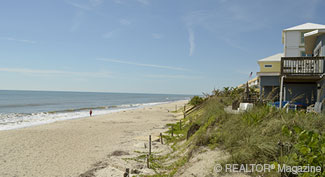
Cautious Optimism
“Today, our biggest hurdle is low inventory,” Artelli says. “I have buyers who are just waiting, and there has been an increase in buyers because there isn’t much available in rentals either.”
It’s far more cost-effective to buy than rent in the area, and many homeowners are in a “nesting” phase, choosing to stay put and invest in upgrading their property rather than trying to move up, Jones says. But Artelli points out that there is a now an onslaught of new construction in parts of the county, including Titusville, Melbourne, and Palm Bay. His parents recently purchased a new home for $224,000 in a development in Titusville. Construction of the development began before the housing bust and then sat unfinished for several years until a new developer bought the empty lots a couple of years ago. Now the project is almost sold out.

The new-construction aesthetic vastly contrasts with the midcentury modern construction that dominates the islands in the eastern part of the county. Built in the 1960s, when the area was exploding during the space race, much of it has been preserved from a time when they dotted the coast as little beach cottages. “I think a lot of these old places will eventually be gone,” Cahill-Ervin says. Cape Canaveral is now a mishmash of newer townhouses, older buildings, new condo high-rises, and beach mansions. But the midcentury homes still line the streets leading up to the beachfront.
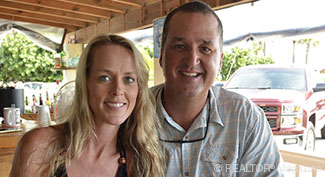
However, one current market trend is giving Schrader pause: He’s seeing many individual investors continuing to scoop up low- to mid-level deals. “When everyone becomes an investor, that’s not a good sign for me,” he says, adding that the irrational exuberance he saw before the housing crash is present again today. He’s worried these individual investors are overbuying, overpaying, and overextending themselves to make money.
Most of the houses Schrader flips are those little 1960s bungalows. He updates the systems, such as the electrical, plumbing, and roof, and then resells them, usually to traditional buyers. He’s also seeing more millennials looking for homes today, which, he says, is a positive sign. “I’m cautiously optimistic,” he says. Once you’ve seen your fair share of storms, you’re always on the lookout for clouds.





